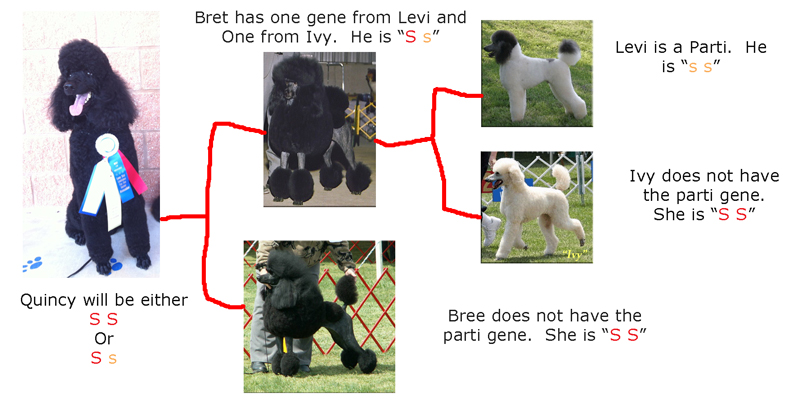There is some really exciting news for all Poodle breeders. VetGen is now offering the Piebald DNA test. What does this mean? We now have a very respectable company able to DNA test Poodles for the parti gene!! This test has been in the works for years, Gloria Ogdahl of Tintlet Poodles has been following it closely and has kept me updated on how the research was going. Last year the researcher was able to do the test if you mailed her samples directly, but it wasn’t being offered ‘publicly’.
For years we have known the Piebald gene is a simple recessive. If you breed two Piebalds (Parti Poodles) together you will get 100% parti pups. If you breed a carrier to a Parti you will get an average of 50% Parti / 50% Solid with and without small white markings but they will all be carriers. The tricky part comes in when you breed two known carriers. You have a chance at 25% NON carriers / 25% Parti pups / 50% carriers. And lastly, where one parent is a known Carrier and one parent is NOT a carrier you get 50% NON carriers and 50% carriers. This is how a gene is carried down many many generations before it crops up far down the line when two carriers come together. Most of my litters fall into this last category.
Now breeders who wish to breed away from the Piebald gene absolutely can do it. They can safely breed their carriers to non-carriers and insure they never see large white spots in their whelping box. Also, for those breeders who enjoy a little splash of color, they can insure they do not lose the gene while breeding to solid non-carrier poodles to increase type or genetic diversity! This is a Win Win situation for all Poodle breeders.
I have ordered the test for Jazz today. I will also be testing Quincy, Piper, and Hazel. Each has one parent who is a carrier. I do not breed for Parti’s, but as most of you know I heavily support good breeders who do and added the gene when Levi was added to our program.
Genetics can be complicated. Below is a photo illustrations to help you understand why this test is useful.

~Becky
